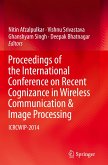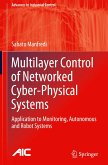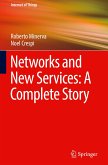- Broschiertes Buch
- Merkliste
- Auf die Merkliste
- Bewerten Bewerten
- Teilen
- Produkt teilen
- Produkterinnerung
- Produkterinnerung
For second and third year introductory communication systems courses for undergraduates, or an introductory graduate course.
This revision of Couch s authoritative text provides the latest treatment of digital communication systems. The author balances coverage of both digital and analog communication systems, with an emphasis on design. Students will gain a working knowledge of both classical mathematical and personal computer methods to analyze, design, and simulate modern communication systems. MATLAB is integrated throughout.
Andere Kunden interessierten sich auch für
![Aircraft Digital Electronic and Computer Systems Aircraft Digital Electronic and Computer Systems]() Mike TooleyAircraft Digital Electronic and Computer Systems47,99 €
Mike TooleyAircraft Digital Electronic and Computer Systems47,99 €![Proceedings of the International Conference on Nano-electronics, Circuits & Communication Systems Proceedings of the International Conference on Nano-electronics, Circuits & Communication Systems]() Proceedings of the International Conference on Nano-electronics, Circuits & Communication Systems113,99 €
Proceedings of the International Conference on Nano-electronics, Circuits & Communication Systems113,99 €![Proceedings of the International Conference on Recent Cognizance in Wireless Communication & Image Processing Proceedings of the International Conference on Recent Cognizance in Wireless Communication & Image Processing]() Proceedings of the International Conference on Recent Cognizance in Wireless Communication & Image Processing228,99 €
Proceedings of the International Conference on Recent Cognizance in Wireless Communication & Image Processing228,99 €![Multilayer Control of Networked Cyber-Physical Systems Multilayer Control of Networked Cyber-Physical Systems]() Sabato ManfrediMultilayer Control of Networked Cyber-Physical Systems91,99 €
Sabato ManfrediMultilayer Control of Networked Cyber-Physical Systems91,99 €![The Art of Music Publishing The Art of Music Publishing]() Helen GammonsThe Art of Music Publishing38,99 €
Helen GammonsThe Art of Music Publishing38,99 €![Principles of Mobile Communication Principles of Mobile Communication]() Gordon L. StüberPrinciples of Mobile Communication107,99 €
Gordon L. StüberPrinciples of Mobile Communication107,99 €![Networks and New Services: A Complete Story Networks and New Services: A Complete Story]() Roberto MinervaNetworks and New Services: A Complete Story83,99 €
Roberto MinervaNetworks and New Services: A Complete Story83,99 €-
-
-
For second and third year introductory communication systems courses for undergraduates, or an introductory graduate course.
This revision of Couch s authoritative text provides the latest treatment of digital communication systems. The author balances coverage of both digital and analog communication systems, with an emphasis on design. Students will gain a working knowledge of both classical mathematical and personal computer methods to analyze, design, and simulate modern communication systems. MATLAB is integrated throughout.
This revision of Couch s authoritative text provides the latest treatment of digital communication systems. The author balances coverage of both digital and analog communication systems, with an emphasis on design. Students will gain a working knowledge of both classical mathematical and personal computer methods to analyze, design, and simulate modern communication systems. MATLAB is integrated throughout.
Produktdetails
- Produktdetails
- Verlag: Pearson
- 8. Aufl.
- Seitenzahl: 792
- Erscheinungstermin: 17. Mai 2012
- Englisch
- Abmessung: 235mm x 178mm x 43mm
- Gewicht: 1160g
- ISBN-13: 9780273774211
- ISBN-10: 0273774212
- Artikelnr.: 35556552
- Herstellerkennzeichnung Die Herstellerinformationen sind derzeit nicht verfügbar.
- Verlag: Pearson
- 8. Aufl.
- Seitenzahl: 792
- Erscheinungstermin: 17. Mai 2012
- Englisch
- Abmessung: 235mm x 178mm x 43mm
- Gewicht: 1160g
- ISBN-13: 9780273774211
- ISBN-10: 0273774212
- Artikelnr.: 35556552
- Herstellerkennzeichnung Die Herstellerinformationen sind derzeit nicht verfügbar.
Preface
List of Symbols
Chapter 1. INTRODUCTION
11 Historical Perspective
12 Digital and Analog Sources and Systems
13 Deterministic and Random Waveforms
14 Organization of the Book
15 Use of a Personal Computer and MATLAB
16 Block Diagram of a Communication System
17 Frequency Allocations
18 Propagation of Electromagnetic Waves
19 Information Measure
110 Channel Capacity and Ideal Communication Systems
111 Coding
Block Codes,
Convolutional Codes,
Code Interleaving,
Code Performance,
Trellis-Coded Modulation,
112 Preview
113 Study-Aid Examples
Problems
Chapter 2. SIGNALS AND SPECTRA
21 Properties of Signals and Noise
Physically Realizable Waveforms
Time Average Operator
DC Value
Power
RMS Value and Normalized Power
Energy and Power Waveforms
Decibel
Phasors
22 Fourier Transform and Spectra
Definition
Properties of Fourier Transforms
Parsevals Theorem and Energy Spectral Density
Dirac Delta Function and Unit Step Function
Rectangular and Triangular Pulses
Convolution
23 Power Spectral Density and Autocorrelation Function
Power Spectral Density
Autocorrelation Function
24 Orthogonal Series Representation of Signals and Noise
Orthogonal Functions
Orthogonal Series
25 Fourier Series
Complex Fourier Series
Quadrature Fourier Series
Polar Fourier Series
Line Spectra for Periodic Waveforms
Power Spectral Density for Periodic Waveforms
26 Review of Linear Systems
Linear Time-Invariant Systems
Impulse Response
Transfer Function
Distortionless Transmission
Distortion of Audio, Video, and Data Signals
27 Bandlimited Signals and Noise
Bandlimited Waveforms
Sampling Theorem
Impulse Sampling and Digital Signal Processing (DSP)
Dimensionality Theorem
28 Discrete Fourier Transform
Using the DFT to Compute the Continuous Fourier Transform
Using the DFT to Compute the Fourier Series0
29 Bandwidth of Signals
210 Summary
211 Study-Aid Examples
Problems
Chapter 3 BASEBAND PULSE AND DIGITAL SIGNALING
31 Introduction
32 Pulse Amplitude Modulation
Natural Sampling (Gating)
Instantaneous Sampling (Flat-Top PAM)
33 Pulse Code Modulation
Sampling, Quantizing, and Encoding
Practical PCM Circuits
Bandwidth of PCM Signals
Effects of Noise
Nonuniform Quantizing: _-Law and A-Law Companding
V.90 56-kb/s PCM Computer Modem
34 Digital Signaling
Vector Representation
Bandwidth Estimation
Binary Signaling
Multilevel Signaling
35 Line Codes and Spectra
Binary Line Coding
Power Spectra for Binary Line Codes
Differential Coding
Eye Patterns
Regenerative Repeaters
Bit Synchronization
Power Spectra for Multilevel Polar NRZ Signals
Spectral Efficiency
36 Intersymbol Interference
Nyquists First Method (Zero ISI)
Raised Cosine-Rolloff Nyquist Filtering
List of Symbols
Chapter 1. INTRODUCTION
11 Historical Perspective
12 Digital and Analog Sources and Systems
13 Deterministic and Random Waveforms
14 Organization of the Book
15 Use of a Personal Computer and MATLAB
16 Block Diagram of a Communication System
17 Frequency Allocations
18 Propagation of Electromagnetic Waves
19 Information Measure
110 Channel Capacity and Ideal Communication Systems
111 Coding
Block Codes,
Convolutional Codes,
Code Interleaving,
Code Performance,
Trellis-Coded Modulation,
112 Preview
113 Study-Aid Examples
Problems
Chapter 2. SIGNALS AND SPECTRA
21 Properties of Signals and Noise
Physically Realizable Waveforms
Time Average Operator
DC Value
Power
RMS Value and Normalized Power
Energy and Power Waveforms
Decibel
Phasors
22 Fourier Transform and Spectra
Definition
Properties of Fourier Transforms
Parsevals Theorem and Energy Spectral Density
Dirac Delta Function and Unit Step Function
Rectangular and Triangular Pulses
Convolution
23 Power Spectral Density and Autocorrelation Function
Power Spectral Density
Autocorrelation Function
24 Orthogonal Series Representation of Signals and Noise
Orthogonal Functions
Orthogonal Series
25 Fourier Series
Complex Fourier Series
Quadrature Fourier Series
Polar Fourier Series
Line Spectra for Periodic Waveforms
Power Spectral Density for Periodic Waveforms
26 Review of Linear Systems
Linear Time-Invariant Systems
Impulse Response
Transfer Function
Distortionless Transmission
Distortion of Audio, Video, and Data Signals
27 Bandlimited Signals and Noise
Bandlimited Waveforms
Sampling Theorem
Impulse Sampling and Digital Signal Processing (DSP)
Dimensionality Theorem
28 Discrete Fourier Transform
Using the DFT to Compute the Continuous Fourier Transform
Using the DFT to Compute the Fourier Series0
29 Bandwidth of Signals
210 Summary
211 Study-Aid Examples
Problems
Chapter 3 BASEBAND PULSE AND DIGITAL SIGNALING
31 Introduction
32 Pulse Amplitude Modulation
Natural Sampling (Gating)
Instantaneous Sampling (Flat-Top PAM)
33 Pulse Code Modulation
Sampling, Quantizing, and Encoding
Practical PCM Circuits
Bandwidth of PCM Signals
Effects of Noise
Nonuniform Quantizing: _-Law and A-Law Companding
V.90 56-kb/s PCM Computer Modem
34 Digital Signaling
Vector Representation
Bandwidth Estimation
Binary Signaling
Multilevel Signaling
35 Line Codes and Spectra
Binary Line Coding
Power Spectra for Binary Line Codes
Differential Coding
Eye Patterns
Regenerative Repeaters
Bit Synchronization
Power Spectra for Multilevel Polar NRZ Signals
Spectral Efficiency
36 Intersymbol Interference
Nyquists First Method (Zero ISI)
Raised Cosine-Rolloff Nyquist Filtering
Preface
List of Symbols
Chapter 1. INTRODUCTION
11 Historical Perspective
12 Digital and Analog Sources and Systems
13 Deterministic and Random Waveforms
14 Organization of the Book
15 Use of a Personal Computer and MATLAB
16 Block Diagram of a Communication System
17 Frequency Allocations
18 Propagation of Electromagnetic Waves
19 Information Measure
110 Channel Capacity and Ideal Communication Systems
111 Coding
Block Codes,
Convolutional Codes,
Code Interleaving,
Code Performance,
Trellis-Coded Modulation,
112 Preview
113 Study-Aid Examples
Problems
Chapter 2. SIGNALS AND SPECTRA
21 Properties of Signals and Noise
Physically Realizable Waveforms
Time Average Operator
DC Value
Power
RMS Value and Normalized Power
Energy and Power Waveforms
Decibel
Phasors
22 Fourier Transform and Spectra
Definition
Properties of Fourier Transforms
Parsevals Theorem and Energy Spectral Density
Dirac Delta Function and Unit Step Function
Rectangular and Triangular Pulses
Convolution
23 Power Spectral Density and Autocorrelation Function
Power Spectral Density
Autocorrelation Function
24 Orthogonal Series Representation of Signals and Noise
Orthogonal Functions
Orthogonal Series
25 Fourier Series
Complex Fourier Series
Quadrature Fourier Series
Polar Fourier Series
Line Spectra for Periodic Waveforms
Power Spectral Density for Periodic Waveforms
26 Review of Linear Systems
Linear Time-Invariant Systems
Impulse Response
Transfer Function
Distortionless Transmission
Distortion of Audio, Video, and Data Signals
27 Bandlimited Signals and Noise
Bandlimited Waveforms
Sampling Theorem
Impulse Sampling and Digital Signal Processing (DSP)
Dimensionality Theorem
28 Discrete Fourier Transform
Using the DFT to Compute the Continuous Fourier Transform
Using the DFT to Compute the Fourier Series0
29 Bandwidth of Signals
210 Summary
211 Study-Aid Examples
Problems
Chapter 3 BASEBAND PULSE AND DIGITAL SIGNALING
31 Introduction
32 Pulse Amplitude Modulation
Natural Sampling (Gating)
Instantaneous Sampling (Flat-Top PAM)
33 Pulse Code Modulation
Sampling, Quantizing, and Encoding
Practical PCM Circuits
Bandwidth of PCM Signals
Effects of Noise
Nonuniform Quantizing: _-Law and A-Law Companding
V.90 56-kb/s PCM Computer Modem
34 Digital Signaling
Vector Representation
Bandwidth Estimation
Binary Signaling
Multilevel Signaling
35 Line Codes and Spectra
Binary Line Coding
Power Spectra for Binary Line Codes
Differential Coding
Eye Patterns
Regenerative Repeaters
Bit Synchronization
Power Spectra for Multilevel Polar NRZ Signals
Spectral Efficiency
36 Intersymbol Interference
Nyquists First Method (Zero ISI)
Raised Cosine-Rolloff Nyquist Filtering
List of Symbols
Chapter 1. INTRODUCTION
11 Historical Perspective
12 Digital and Analog Sources and Systems
13 Deterministic and Random Waveforms
14 Organization of the Book
15 Use of a Personal Computer and MATLAB
16 Block Diagram of a Communication System
17 Frequency Allocations
18 Propagation of Electromagnetic Waves
19 Information Measure
110 Channel Capacity and Ideal Communication Systems
111 Coding
Block Codes,
Convolutional Codes,
Code Interleaving,
Code Performance,
Trellis-Coded Modulation,
112 Preview
113 Study-Aid Examples
Problems
Chapter 2. SIGNALS AND SPECTRA
21 Properties of Signals and Noise
Physically Realizable Waveforms
Time Average Operator
DC Value
Power
RMS Value and Normalized Power
Energy and Power Waveforms
Decibel
Phasors
22 Fourier Transform and Spectra
Definition
Properties of Fourier Transforms
Parsevals Theorem and Energy Spectral Density
Dirac Delta Function and Unit Step Function
Rectangular and Triangular Pulses
Convolution
23 Power Spectral Density and Autocorrelation Function
Power Spectral Density
Autocorrelation Function
24 Orthogonal Series Representation of Signals and Noise
Orthogonal Functions
Orthogonal Series
25 Fourier Series
Complex Fourier Series
Quadrature Fourier Series
Polar Fourier Series
Line Spectra for Periodic Waveforms
Power Spectral Density for Periodic Waveforms
26 Review of Linear Systems
Linear Time-Invariant Systems
Impulse Response
Transfer Function
Distortionless Transmission
Distortion of Audio, Video, and Data Signals
27 Bandlimited Signals and Noise
Bandlimited Waveforms
Sampling Theorem
Impulse Sampling and Digital Signal Processing (DSP)
Dimensionality Theorem
28 Discrete Fourier Transform
Using the DFT to Compute the Continuous Fourier Transform
Using the DFT to Compute the Fourier Series0
29 Bandwidth of Signals
210 Summary
211 Study-Aid Examples
Problems
Chapter 3 BASEBAND PULSE AND DIGITAL SIGNALING
31 Introduction
32 Pulse Amplitude Modulation
Natural Sampling (Gating)
Instantaneous Sampling (Flat-Top PAM)
33 Pulse Code Modulation
Sampling, Quantizing, and Encoding
Practical PCM Circuits
Bandwidth of PCM Signals
Effects of Noise
Nonuniform Quantizing: _-Law and A-Law Companding
V.90 56-kb/s PCM Computer Modem
34 Digital Signaling
Vector Representation
Bandwidth Estimation
Binary Signaling
Multilevel Signaling
35 Line Codes and Spectra
Binary Line Coding
Power Spectra for Binary Line Codes
Differential Coding
Eye Patterns
Regenerative Repeaters
Bit Synchronization
Power Spectra for Multilevel Polar NRZ Signals
Spectral Efficiency
36 Intersymbol Interference
Nyquists First Method (Zero ISI)
Raised Cosine-Rolloff Nyquist Filtering








